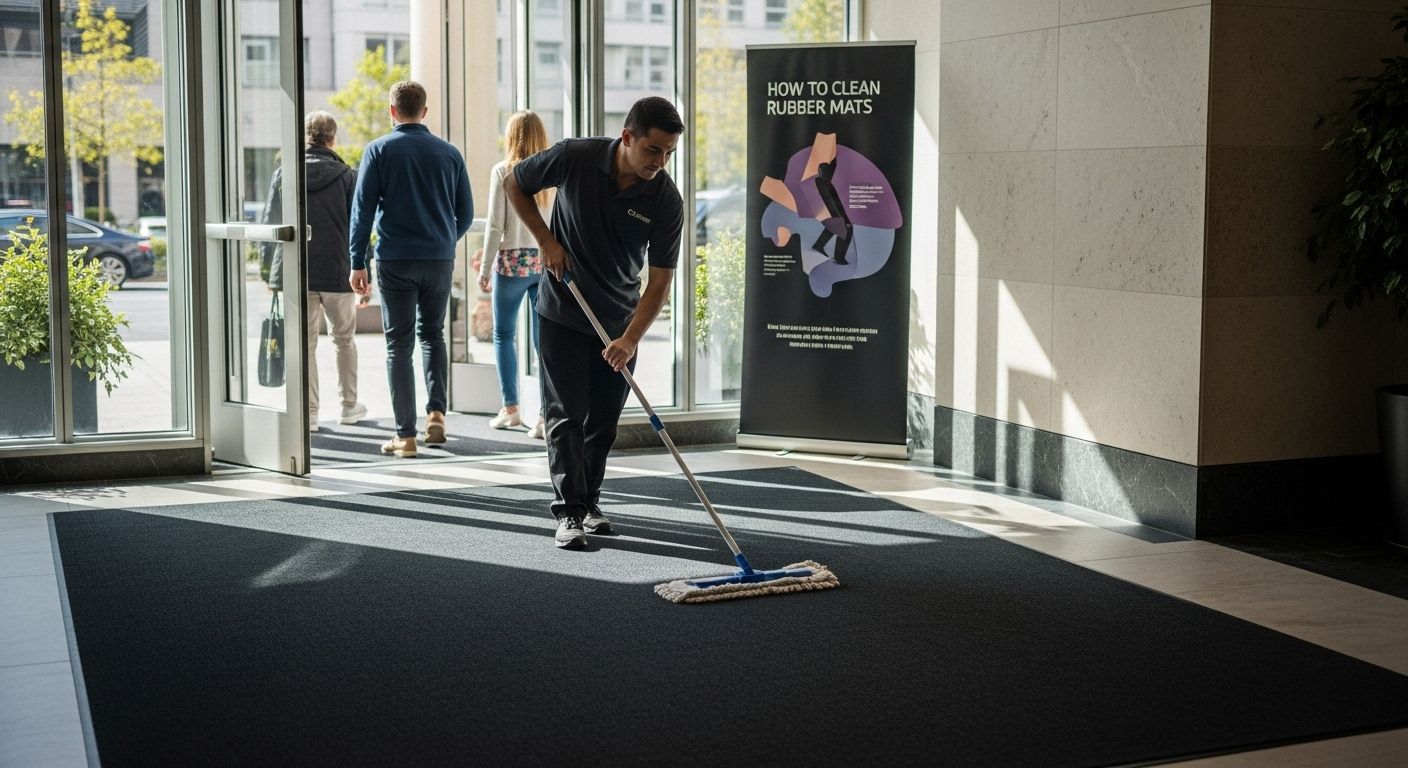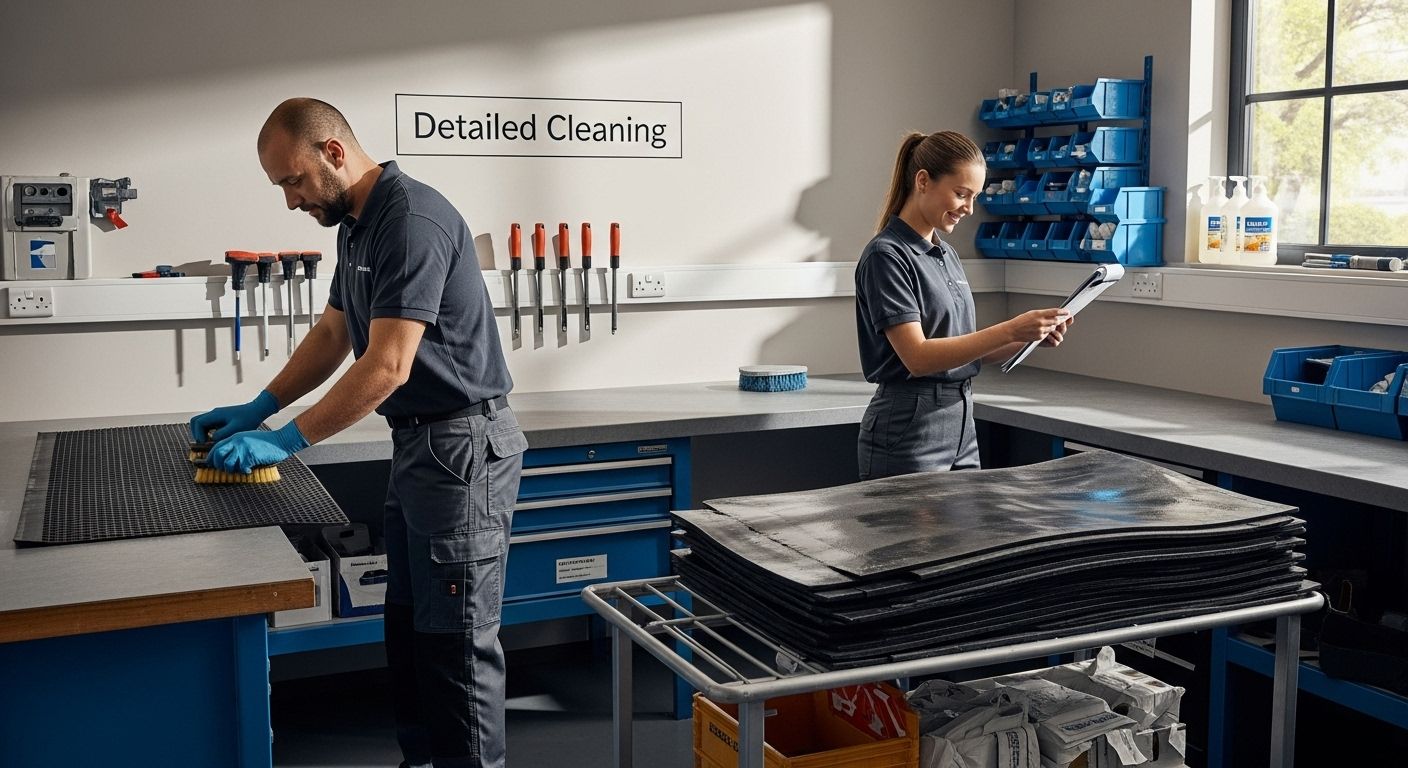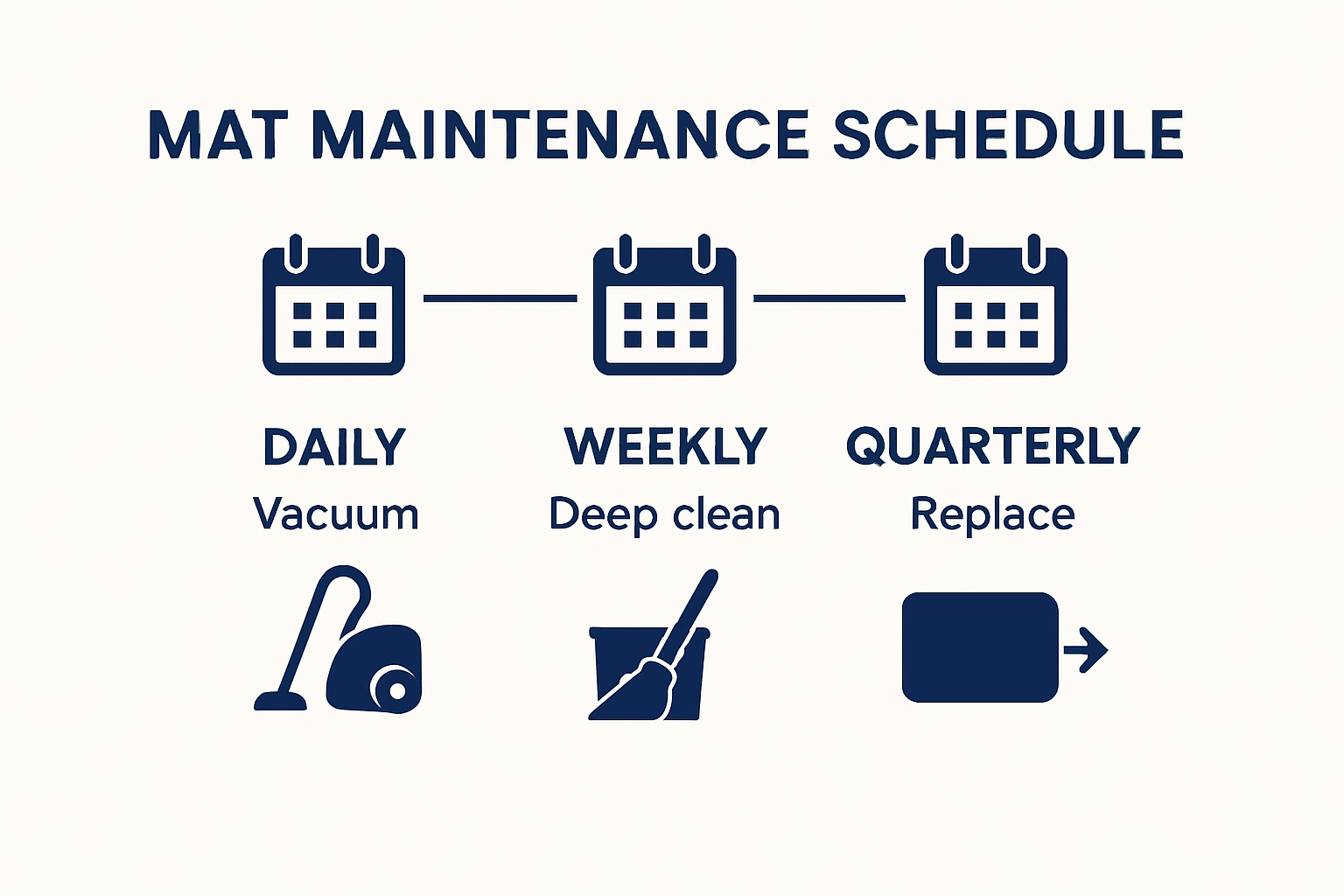
Rubber mats collect dirt, bacteria, and allergens every single day right as people walk into your business. Sure these mats seem like a simple layer of protection and comfort, but most people miss one huge fact. Dirty rubber mats can actually become a major safety hazard and hurt your bottom line by forcing more frequent replacements and causing slip risks. Turns out, keeping them clean is less about looks and more about serious savings and health.
Table of Contents
- Why Regular Rubber Mat Cleaning Matters
- Essential Tools And Products For Cleaning
- Step-By-Step Process To Clean Rubber Mats
- Tips For Maintaining Rubber Mats In Busy Facilities
Quick Summary
| Takeaway | Explanation |
|---|---|
| Regular cleaning enhances safety and longevity | Dirty rubber mats attract contaminants which can cause safety hazards and reduce their lifespan. Regular maintenance is essential. |
| Invest in appropriate cleaning tools | Use industrial-grade vacuums, microfiber mops, and soft-bristled brushes to effectively clean without damaging mats. |
| Establish a comprehensive maintenance schedule | Implement daily, weekly, and monthly cleaning protocols to prevent dirt buildup and ensure mat effectiveness in high-traffic areas. |
| Use pH-neutral cleaning solutions | Mild, pH-neutral cleaners prevent damage to rubber surfaces while effectively sanitizing mats and eliminating bacteria. |
| Proper mat placement prevents dirt accumulation | Strategic positioning and using multiple mats can significantly reduce soil transfer and maintain cleanliness in busy facilities. |
Why Regular Rubber Mat Cleaning Matters
Rubber mats are critical investments for businesses across multiple industries, serving as the first line of defense against dirt, moisture, and potential safety hazards. Understanding the importance of regular cleaning goes far beyond mere aesthetic maintenance.
The Hidden Impact of Dirty Mats on Business Operations
Contrary to common perception, rubber mats are not self-cleaning surfaces. They actively collect and trap contaminants from foot traffic, which can quickly compromise their functionality and appearance. The General Services Administration’s Sustainable Facilities Tool emphasizes that entrance mats play a crucial role in trapping dirt and improving indoor air quality. When these mats are not regularly cleaned, they transform from protective barriers into potential sources of contamination.
Businesses that neglect mat maintenance face several significant risks. Accumulated dirt and debris can reduce mat effectiveness, potentially leading to increased cleaning costs for entire facilities. Moreover, dirty mats can become breeding grounds for bacteria, mold, and allergens, creating potential health risks for employees and visitors. The New York State Office of General Services recommends establishing comprehensive cleaning protocols to prevent the spread of contaminants.
Economic and Safety Implications of Regular Mat Maintenance
Regular cleaning is not just about appearance it’s a strategic business practice. Professionally maintained rubber mats extend their operational lifespan, provide consistent performance, and contribute to a professional workplace environment. The International Association of Certified Home Inspectors recommends daily vacuuming and periodic deep cleaning to minimize dust accumulation and prevent potential slip hazards.
Consider the economic perspective. A well-maintained rubber mat can last significantly longer than a neglected one, reducing replacement frequency and associated costs. For businesses with high-traffic areas, this translates into substantial long-term savings. Additionally, clean mats maintain their slip-resistant properties, which is crucial for workplace safety and potential liability reduction.
Furthermore, regular cleaning communicates a commitment to professional standards. When clients, customers, or potential business partners enter a facility with pristine, well-maintained mats, it sends a powerful message about the organization’s attention to detail and commitment to excellence. Read our comprehensive guide on maintaining commercial floor mats to understand how strategic maintenance can elevate your business environment.
Ultimately, rubber mat cleaning is not an optional task but a critical component of facility management. By implementing consistent, thorough cleaning practices, businesses can protect their investment, ensure workplace safety, and project a professional image that speaks volumes about their operational standards.
Essential Tools and Products for Cleaning
Successful rubber mat cleaning requires a strategic approach with the right equipment and cleaning solutions. Businesses must invest in high-quality tools that effectively remove dirt, prevent damage, and maintain the mat’s performance and appearance.
Recommended Cleaning Equipment
Professional mat maintenance begins with selecting appropriate cleaning tools. The New York State Office of General Services recommends using high-performance cleaning equipment with low environmental impact. This includes HEPA filtration vacuum cleaners and microfiber mops, which are particularly effective for thorough dirt removal.
Key equipment for rubber mat cleaning includes:
- Vacuum Cleaners: Industrial-grade vacuums with strong suction and attachments for detailed cleaning
- Microfiber Mops: Excellent for capturing fine particles without scratching the mat surface
- Soft-Bristled Brushes: Useful for gentle scrubbing without damaging rubber material
- Squeegees: Help remove excess moisture and prevent water pooling
Selecting the Right Cleaning Solutions
Choosing appropriate cleaning products is crucial for maintaining rubber mat integrity. The International Association of Certified Home Inspectors warns against using harsh chemicals that can damage rubber surfaces. Acidic solvents, acetone, turpentine, and petroleum-based cleaners should be strictly avoided.
Instead, businesses should opt for:
- Mild Soap Solutions: Gentle, pH-neutral cleaners specifically designed for rubber surfaces
- Specialized Rubber Mat Cleaners: Commercial-grade products formulated to clean without degrading mat material
- Disinfectant Solutions: EPA-approved disinfectants that effectively eliminate bacteria without compromising mat quality
Interestingly, research published in The Sport Journal revealed that the method of disinfectant application can significantly impact cleaning effectiveness. Flat mops with direct disinfectant application demonstrated superior microorganism reduction compared to traditional string mop techniques.
Additionally, discover our comprehensive guide to maintaining commercial floor mats for more detailed insights into proper mat care and maintenance strategies.
By investing in the right tools and cleaning solutions, businesses can ensure their rubber mats remain clean, hygienic, and functional. Proper equipment not only extends mat lifespan but also contributes to a safer, more professional workplace environment.
To help you select the most effective cleaning supplies for rubber mats, here’s a summary table of recommended equipment and cleaning solutions, along with their purpose and notes on usage.
| Tool / Solution | Purpose | Notes / Recommendations |
|---|---|---|
| Vacuum Cleaner | Remove loose dust and debris | Use industrial-grade with HEPA filtration |
| Microfiber Mop | Capture fine particles | Prevents scratches on mat surface |
| Soft-Bristled Brush | Gentle scrubbing of mat surface | Avoids damaging rubber material |
| Squeegee | Remove excess moisture | Prevents water pooling |
| Mild Soap (pH-neutral) | Clean and sanitize mat | Never use acidic/harsh chemicals |
| Specialized Rubber Mat Cleaner | Deep clean without damage | Commercial-grade, formulated for rubber |
| Disinfectant (EPA-approved) | Eliminate bacteria and germs | Ensure compatibility with rubber |
Step-by-Step Process to Clean Rubber Mats
Cleaning rubber mats requires a systematic approach to ensure thorough sanitization without compromising the mat’s integrity. By following a structured process, businesses can maintain their mats’ appearance, functionality, and longevity.
Initial Preparation and Assessment
Before beginning the cleaning process, conduct a comprehensive assessment of the rubber mat. The International Association of Certified Home Inspectors emphasizes the importance of identifying the mat’s specific condition and potential areas of wear. Remove any loose debris by thoroughly vacuuming the mat, paying special attention to corners and textured surfaces.
Key preparation steps include:
- Removing loose objects and debris from the mat surface
- Checking for any existing damage or significant wear
- Identifying the specific type of rubber mat to determine appropriate cleaning methods
- Gathering all necessary cleaning supplies in advance
Detailed Cleaning Technique
The U.S. General Services Administration recommends using synthetic, non-ionic, neutral pH detergents for effective cleaning. Begin by preparing a cleaning solution using mild, pH-neutral soap mixed with warm water. Avoid harsh chemicals that can damage the rubber surface.
Follow this systematic cleaning approach:
- Mix a gentle cleaning solution using mild soap and warm water
- Use a soft-bristled brush or microfiber mop to apply the solution
- Gently scrub the mat, working in small sections
- Use a squeegee to remove excess moisture
- Allow the mat to air dry completely before replacing
Deep Cleaning and Maintenance Protocols
Periodic deep cleaning is crucial for maintaining rubber mat performance. The New York State Office of General Services advocates for establishing routine maintenance programs that go beyond daily cleaning. For high-traffic areas, consider more intensive cleaning methods every few weeks.
Advanced maintenance tips include:
- Using specialized rubber mat cleaning solutions
- Applying a protective finish to prevent scuffing
- Implementing a regular inspection schedule
- Learn more about maintaining industrial floor coverings to extend mat life and performance
Caution is paramount during the cleaning process. Avoid using high-speed burnishers, acetone, or petroleum-based cleaners that can cause permanent damage to rubber mats. Each cleaning session should be approached with care, using gentle techniques that preserve the mat’s protective properties.
By following these systematic steps, businesses can ensure their rubber mats remain clean, safe, and functional. Regular maintenance not only extends the mat’s lifespan but also contributes to a safer, more professional workplace environment. Consistency is key in preserving the quality and effectiveness of rubber floor coverings.

Tips for Maintaining Rubber Mats in Busy Facilities
Maintaining rubber mats in high-traffic environments requires strategic planning and proactive management. Businesses with busy facilities must implement comprehensive maintenance strategies to ensure mat longevity, safety, and performance.
Strategic Placement and Preventative Measures
The Centers for Disease Control and Prevention emphasizes the critical role of floor maintenance in reducing workplace accidents. Proper mat placement is the first line of defense in maintaining rubber mats in busy facilities. Strategic positioning can significantly minimize dirt accumulation and wear.
Key preventative strategies include:
- Implementing multiple mat layers at facility entrances
- Using different mat types for specific zones (high-traffic vs. low-traffic areas)
- Creating designated cleaning stations near mat entry points
- Rotating mats periodically to distribute wear evenly
- Installing protective barriers to reduce direct soil and moisture transfer
Regular Maintenance Scheduling
Consistent maintenance is crucial for preserving rubber mat integrity in busy environments. Develop a comprehensive cleaning schedule that addresses daily, weekly, and monthly maintenance requirements. High-traffic areas demand more frequent attention to prevent dirt buildup and potential safety hazards.
Recommended maintenance frequency:

- Daily: Quick vacuuming and spot cleaning
- Weekly: Thorough cleaning and detailed inspection
- Monthly: Deep cleaning and potential minor repairs
- Quarterly: Comprehensive mat assessment and potential replacement of most-worn mats
To clarify the recommended mat cleaning routine, the following table outlines the key steps and frequency for maintaining rubber mats in busy facilities.
| Maintenance Task | Frequency | Description |
|---|---|---|
| Vacuuming/Spot Cleaning | Daily | Remove loose dirt, quick spot checks |
| Thorough Cleaning | Weekly | Detailed cleaning, includes scrubbing and inspection |
| Deep Cleaning | Monthly | Intensive cleaning, focus on persistent dirt and minor repairs |
| Mat Assessment | Quarterly | Comprehensive review, consider replacing most-worn mats |
This schedule ensures that facilities maintain optimal safety, cleanliness, and mat longevity.
Advanced Maintenance Techniques
Beyond basic cleaning, busy facilities require advanced maintenance approaches. Explore our comprehensive guide to commercial floor mat solutions to understand sophisticated maintenance techniques. Consider implementing specialized protocols for different facility zones, such as industrial areas, reception spaces, and high-moisture environments.
Advanced maintenance techniques include:
- Using specialized cleaning equipment designed for heavy-duty rubber mats
- Implementing protective treatments to enhance mat durability
- Training staff on proper mat maintenance procedures
- Utilizing digital tracking systems to monitor mat wear and replacement cycles
- Investing in high-quality mats with enhanced durability features
Proper documentation is equally important. Maintain detailed records of mat cleaning, inspection, and replacement cycles. This approach not only ensures consistent maintenance but also helps track long-term mat performance and replacement costs.
Businesses must recognize that rubber mat maintenance is an ongoing process requiring continuous attention and adaptation. By implementing these comprehensive strategies, organizations can maximize the performance, safety, and appearance of their rubber mats in even the busiest facility environments. Regular assessment, proactive maintenance, and strategic investment are key to achieving optimal results.
Frequently Asked Questions
What tools are essential for cleaning rubber mats?
Key tools for cleaning rubber mats include industrial-grade vacuums, microfiber mops, soft-bristled brushes, and squeegees. These tools help effectively remove dirt without damaging the mats.
What cleaning solutions are safe to use on rubber mats?
Mild, pH-neutral soap solutions and specialized rubber mat cleaners are safe to use. Avoid harsh chemicals like acidic solvents and petroleum-based cleaners, as they can damage the rubber material.
How often should rubber mats be cleaned in high-traffic areas?
In high-traffic areas, it’s recommended to vacuum daily, perform a thorough cleaning weekly, and conduct a deep clean monthly. Regular inspections should also be scheduled quarterly to assess wear and potential replacements.
What steps should be taken for deep cleaning rubber mats?
Deep cleaning involves removing debris, preparing a mild cleaning solution, scrubbing the mats gently with a soft-bristled brush, removing excess moisture with a squeegee, and allowing the mats to air dry completely before returning them to service.
Keep Your Rubber Mats Clean and Safe with Mats4U Solutions
Is your business struggling to keep up with dirty, worn-out, or slippery rubber mats in busy areas? As highlighted in our guide, regular maintenance is critical to prevent slip risks, protect indoor air quality, and avoid costly replacements. But if your current mats are hard to keep clean or no longer performing, it may be time to upgrade. Explore our Non Slip collection, featuring durable, easy-to-clean rubber mats specifically designed for high-traffic and industrial environments.
Do not wait until safety or appearance become a concern for your workplace. Find the right mat for your needs by visiting Mats4U.com, where you will discover a wide selection of commercial floor mats built to last. Shop now and see why businesses nationwide trust Mats4U for dependable, cost-effective solutions.







